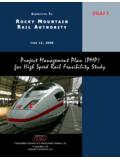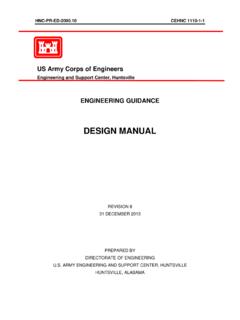Transcription of Feasibility Study Model
1 Feasibility Study Modelfor Cage Farming business of Small-Medium SizeStrengthening and supporting further development of aquaculture in the Kingdom of Saudi ArabiaPROJECT UTF/SAU/048/SAUC over photograph:A floating cage in the Tabuk Fisheries Company farm, located off the Red Sea coast of Saudi Arabia in the northern coastal province of Tabuk.(Courtesy Richard Antony Corner) Feasibility Study MODELfor Cage Farming business of Small-Medium SizeAlessandro CiattagliaFAO Consultant Published by the Food and Agriculture Organization of the United Nations and the Ministry of Environment, Water and Agriculture in the Kingdom of Saudi Arabia The designations employed and the presentation of material in this information product do not imply the expression of any opinion whatsoever on the part of the Food and Agriculture Organization of the United Nations (FAO)
2 , or of the Ministry of Environment, Water and Agriculture in the Kingdom of Saudi Arabia concerning the legal or development status of any country, territory, city or area or of its authorities, or concerning the delimitation of its frontiers or boundaries. The mention of specific companies or products of manufacturers, whether or not these have been patented, does not imply that these have been endorsed or recommended by FAO, or the Ministry in preference to others of a similar nature that are not mentioned. The views expressed in this information product are those of the author(s) and do not necessarily reflect the views or policies of FAO, or the 978-92-5-009599-8 (FAO) FAO, 2017 FAO encourages the use, reproduction and dissemination of material in this information product.
3 Except where otherwise indicated, material may be copied, downloaded and printed for private Study , research and teaching purposes, or for use in non-commercial products or services, provided that appropriate acknowledgement of FAO as the source and copyright holder is given and that FAO s endorsement of users views, products or services is not implied in any requests for translation and adaptation rights, and for resale and other commercial use rights should be made via or addressed to information products are available on the FAO website ( ) and can be purchased through.
4 4 EXECUTIVE SUMMARY .. 7 THE PROJECT .. 9 Project Description .. 9 Ownership .. 9 Introduction .. 9 The Selected Site .. 9 The Technology used .. 9 Time Scheduling .. 10 PRODUCTS & SERVICES .. 12 Overview .. 12 Product Overview .. 12 Service Overview .. 12 Features & Benefits .. 12 Sourcing .. 12 Long-Term Vision .. 12 PROJECT KEY INFORMATION .. 14 Data Overview .. 14 MARKET ANALYSIS .. 15 Market Overview .. 15 The MARKET DEMAND: Target Market .. 15 The MARKET DEMAND: Target Market 16 The MARKET SUPPLY: Industry 16 The MARKET SUPPLY: Competitive Analysis.
5 17 The MARKET SUPPLY: SWOT Analysis .. 18 The MARKET SUPPLY: Market Potential .. 18 MARKETING STRATEGY .. 20 Strategy Overview .. 20 Mission .. 20 Strategies .. 20 THE MANAGEMENT .. 22 Management Summary .. 22 Management .. 22 Current Staff .. 22 Required Staff .. 22 Recruitment options .. 22 Training programs .. 23 FINANCIAL PLAN .. 24 Overview .. 243 Finance required .. 24 Assumption .. 24 Investments and Start-up costs for [YEAR] table .. 24 Balance Sheet forecast table .. 24 Profit & Loss forecast table .. 24 Expected Cash Flow table .. 25 Break-Even Analysis table.
6 25 SUPPORTING DOCUMENTATION .. 26 Supporting documentation .. 26 ANNEX - Feasibility Study MODELS FORMS (Excel File) .. 264 INTRODUCTIONFEASABILITY Study MODELfor CAGE FARMING business of SMALL/MEDIUM SIZEC onceptThe following pages provide a Feasibility Study Model (FSM) for drafting a comprehensive Feasibility Study (FS) for small and medium cage aquaculture Projects. This includes a short business Plan Model for a Start-up cage fish farming. The topics in this FSM are designed for the start-up of small to medium fish farm projects. The difference between this Model and one used for larger business models and private capital is in the depth of research and topics necessary for a large project and not applicable to a smaller FS is required to justify Applicant s use of public sea shore and sea water, as a shared resource, for the purpose of carrying out cage FSM has chapters that define the business Model .
7 The Financial section of the plan should highlight Applicant s funding requirements, if needed, and the important elements of Applicant s financial projections. The applicant s financial projection worksheets must be attached for FS is structured in a formalized way though the order in which specific tasks are carried out may be different from how it is presented in the document. For example the FS begins with the Executive Summary, but this is the last step in the process, summarizing what has been drafted in the Study ). The following chapters form the structure of Applicant s plan.
8 The number in brackets gives a suggested sequence to consider in Applicant s planning process. Executive Summary (#8) Summarizes the key elements of the FS The Project(#7) Presents an overview of the business Product/Services(#2) Defines the product/Fish Species menu and any Service Technology Consideration(#3) Defines the technology used Market Analysis (# 1) Assesses the market situation 5 Marketing Strategy (# 6) Defines strategies necessary to fulfill the financial plan Management (# 4) Defines the management/staff Model Financial Plan (# 5)
9 Develops financial projections and assesses performance TopicsEach topic starts with explaining the theory behind the topic followed by some suggested items and tips on market information sources where applicable. Theory is presented in blue and the suggested items in business name as Applicant s customers will see it. It may be different than Applicant s legal name. Applicant may insert a logo as well. Follow by inserting the type of business and Applicant s tag line. If you don t have one, it s a good time to start thinking about how to augment Applicant s identity.
10 You can add it later. Complete the Contact information and when satisfied, delete these instructions. CAGE FARMFish Farming in Open Sea Applicant s Slogan Feasibility Study AND SHORT business PLANC ontact:Address:Telephone:Email:7 EXECUTIVE SUMMARY>The Executive Summary is needed to provide the reader with a general overview of the project in a clear and concise manner.















